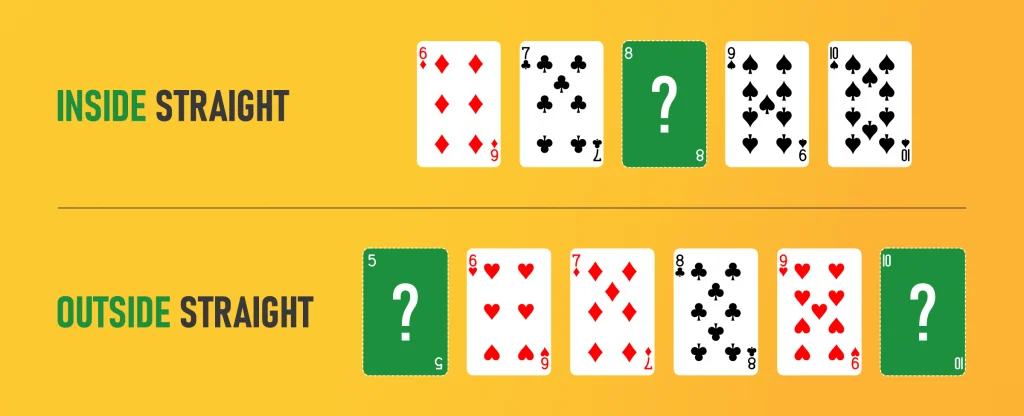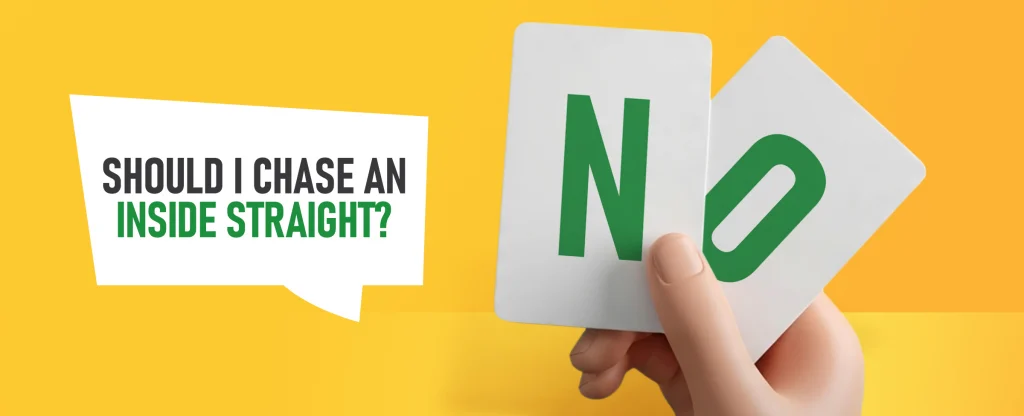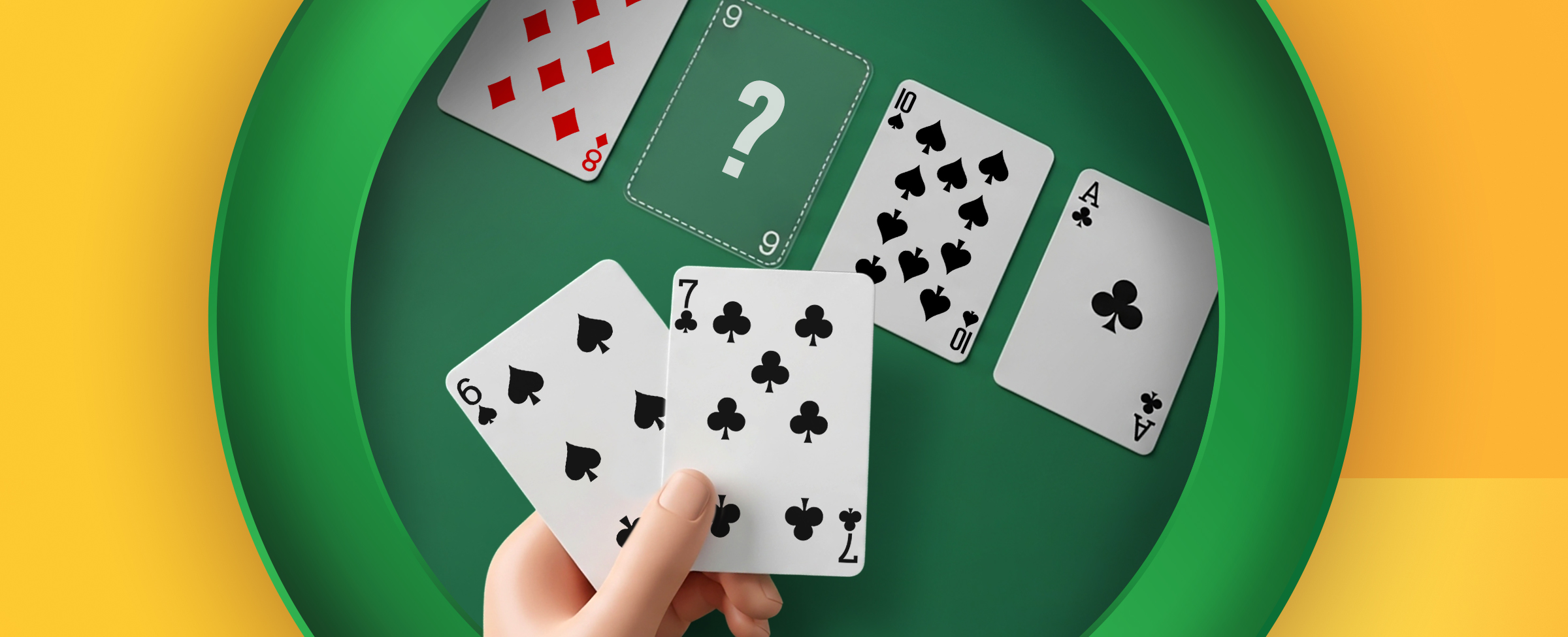Poker is a game of strategy, timing, reading your opponents, and of course, sometimes a little bit of luck. One of the terms you’ll often hear thrown around at the table is the “inside straight draw”. It sounds fancy, but it’s common but easy to misunderstand. If you’re just getting into poker, or if you’ve heard the term but aren’t quite sure what it means, don’t stress. Here at Joe Fortune, we’ll help break it down in simple terms, with examples that make sense. We’ll also explain why chasing an inside straight is usually a bad idea, especially in Texas Hold’em, and what you should be doing instead.
What is an Inside Straight in Poker?
An inside straight, also known as a gutshot straight draw, occurs when you’ve got four cards to a straight, but you’re missing the one card in the middle in effect you require only one card that you must hit to land that straight.
Inside Straight Example
If you’re holding 6♠ and 7♣, and the flop comes down 8♦, 10♠, and A♣, then you’re only missing the 9 to complete your straight. But the catch is that only one specific rank forms the inside straight, in this example, the 9 will give you the combination you want. It’s called an ‘inside’ straight because the missing card is inside the sequence, unlike an open-ended straight draw where you have two ways to hit what you’re after. This is a classic inside straight draw. You only have one rank – the 9 – that helps you out. Even though there are four 9s in the deck that’s still just four outs, which isn’t much to go on.
Outs
In poker, an “out” is a card that will improve your hand. With an inside straight draw, you’ve usually only got four outs – the four cards of that specific missing rank. Compared to other draws, that’s slim. If you’re drawing to a flush, for example, you might have nine outs. For an open-ended straight draw, you’ve usually got eight. So inside straight draws sit low on the value list.
Difference Between Inside and Outside Straight

- Inside Straight (Gutshot) this is where you’re missing one card *in the middle* of a straight. For example: 6-7-9-10 (missing the 8). You only have four outs.
- Outside Straight (Open-Ended) in this hand you’re missing one card on either end of a straight. For example: 6-7-8-9 (missing the 5 or 10). That gives you ‘eight outs’. Open-ended straight draws are generally better because you’ve got twice the chance to hit your card.
What Does It Mean to Never Draw to an Inside Straight?
You might have heard the old poker saying, “Never draw to an inside straight.” And what that means is simple, don’t chase a hand that has such a low chance of improving. It’s often not worth the risk, especially if you must call a big bet to see another card. Inside straight draws are seen as “long shots”, and experienced players usually avoid them unless the pot odds or other factors make it worth a gamble.
Why You Should Never Draw To…
Chasing an inside straight draw is usually considered a rookie mistake and here’s why that is the case:
Lower Probabilities of Hitting
Let’s talk numbers. With an inside straight draw, you’ve only got four outs. If you’re on the flop and waiting to see the turn or river, your chance of hitting your card by the river is about 16 – 17% which is not much. If you’re just waiting for one card, say for e.g. from the turn to the river, your odds drop to around 8.5%. That’s grim odds for putting more chips into the pot.
Cost vs Reward
When you’re thinking about whether to call a bet on an inside straight draw, you’ve got to weigh up the cost of calling against the potential reward i.e. what’s already in the pot. Let’s face it, if the pot’s small, and someone bets big, calling just to hit a 4-out draw isn’t a wise move or good way of gambling. You’re likely just throwing your chips away. Sure, if you hit it, it feels great, but the stats say that most of the time, you’ll miss and lose your investment. The maths usually doesn’t justify it.
Better Options
Rather than hoping for a gutshot to land, there are often better plays starting with:
- Bluff. If you think your opponent is weak, you might consider representing a strong hand and bluffing instead of hoping to hit a long shot.
- Fold. There’s no shame in folding a hand that doesn’t have good potential.
- Look for Better Draw. A flush draw, open-ended straight, or even top pair with a good kicker gives you more equity and better odds to win.
Inside Straight Odds in Texas Hold’em
Let’s break it down specifically for Texas Hold’em. After the flop, with an inside straight draw, you’ve got four outs. The chance of hitting your card on the turn alone is about 8.5%. The chance of hitting your card by the river is about 16.5%. If you’re facing a bet and wondering whether to call, you’ll want to compare the size of the pot to the cost of calling. That’s known as pot odds.
Example
If the pot is $100 and someone bets $10, you’re getting 10-to-1 odds. That might justify calling with four outs, since your chance is roughly 1 in 6 to hit by the river. But if the bet is $50, and the pot is $100, you’re only getting 2-to-1, which is pretty poor value for such a long shot. In general, you want pot odds that exceed your drawing odds. With an inside straight as you might now be starting to understand that’s hard to come by.

In Summary: Should You Ever Chase an Inside Straight?
In most cases, the answer is no, chasing an inside straight usually isn’t worth it. While it can be tempting when you’re just one card away from hitting a strong hand, the odds are low, and the risk is often too high. Poker is a game of patience, discipline, and long-term strategy. Winning players focus on solid decisions over time, not just chasing hands that look good but rarely hit.
That said, there are some situations where it might make sense. If the bet you’re facing is small, the pot is already quite large, and you believe you’ll get a nice payout if you do hit your straight, then it might be worth a shot. This is especially true if you’re in a position where you can also bluff later, or if your opponent is likely to pay you off.
But those spots are the exception, not the rule. Most of the time, an inside straight draw just doesn’t give you good enough odds to justify calling a bet. Instead of hoping for that one perfect card, you’re usually better off folding, looking for stronger hands, or finding a smarter way to play the round. In short: don’t fall into the trap. Know the numbers, trust your judgement, and save your chips for better opportunities.
Final Thoughts
Inside straight draws are a part of poker, and you’ll see them all the time. But just because you can draw to them doesn’t mean you should. The odds are low, the cost is often high, and there are usually better options on the table. If you want to improve your game, learn when to let these hands go and focus on draws and plays that give you better chances of winning. Poker is a game of skill and discipline, so it is best to try avoiding the trap of an inside straight for starters if you’re looking to improve your game play.
